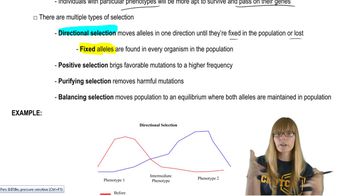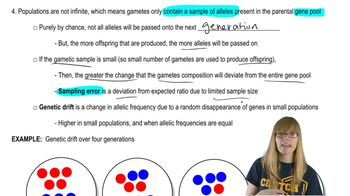Table of contents
- 1. Introduction to Genetics51m
- 2. Mendel's Laws of Inheritance3h 37m
- 3. Extensions to Mendelian Inheritance2h 41m
- 4. Genetic Mapping and Linkage2h 28m
- 5. Genetics of Bacteria and Viruses1h 21m
- 6. Chromosomal Variation1h 48m
- 7. DNA and Chromosome Structure56m
- 8. DNA Replication1h 10m
- 9. Mitosis and Meiosis1h 34m
- 10. Transcription1h 0m
- 11. Translation58m
- 12. Gene Regulation in Prokaryotes1h 19m
- 13. Gene Regulation in Eukaryotes44m
- 14. Genetic Control of Development44m
- 15. Genomes and Genomics1h 50m
- 16. Transposable Elements47m
- 17. Mutation, Repair, and Recombination1h 6m
- 18. Molecular Genetic Tools19m
- 19. Cancer Genetics29m
- 20. Quantitative Genetics1h 26m
- 21. Population Genetics50m
- 22. Evolutionary Genetics29m
21. Population Genetics
Allelic Frequency Changes
Problem 38
Textbook Question
Textbook QuestionAchromatopsia is a rare autosomal recessive form of complete color blindness that affects about 1 in 20,000 people in most populations. People with this disorder see only in black and white and have extreme sensitivity to light and poor visual acuity. On Pingelap Island, one of a cluster of coral atoll islands in the Federated States of Micronesia, approximately 10% of the 3000 indigenous Pingelapese inhabitants have achromatopsia. Achromatopsia was first recorded on Pingelap in the mid-1800s, about four generations after a typhoon devastated Pingelap and reduced the island population to about 20 people. All Pingelapese with achromatopsia trace their ancestry to one male who was one of the 20 typhoon survivors. Provide a genetic explanation for the origin of achromatopsia on Pingelap, and explain the most likely evolutionary model for the high frequency there of achromatopsia.
 Verified Solution
Verified SolutionThis video solution was recommended by our tutors as helpful for the problem above
Video duration:
2mPlay a video:
205
views
Was this helpful?




